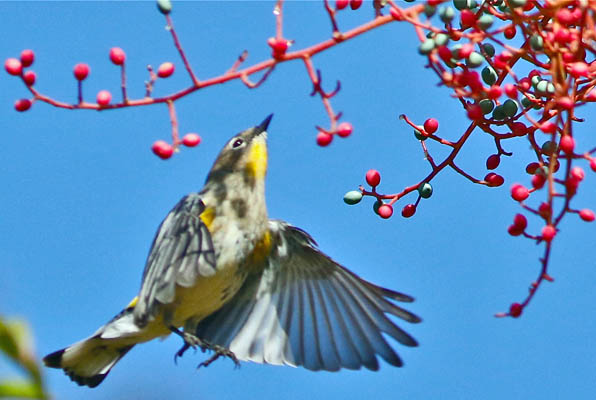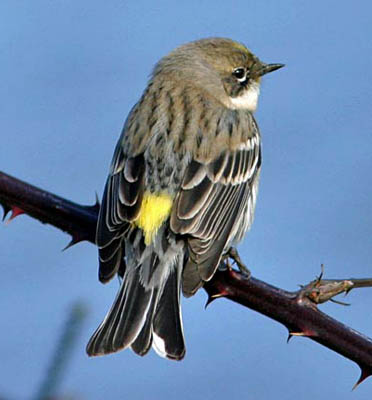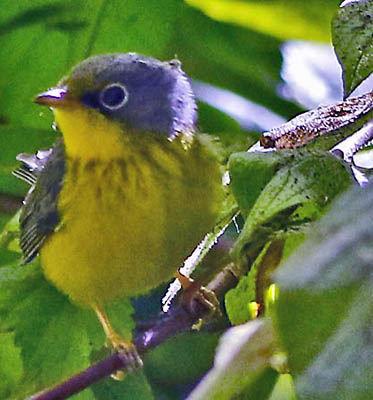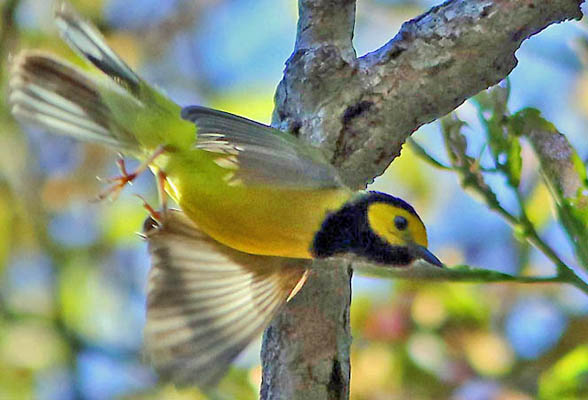| |
 |
NEW WORLD WARBLERS Parulidae |
- 109 species in the Western Hemisphere
- DR personal total: 87 species (80%), 58 photo'd
|
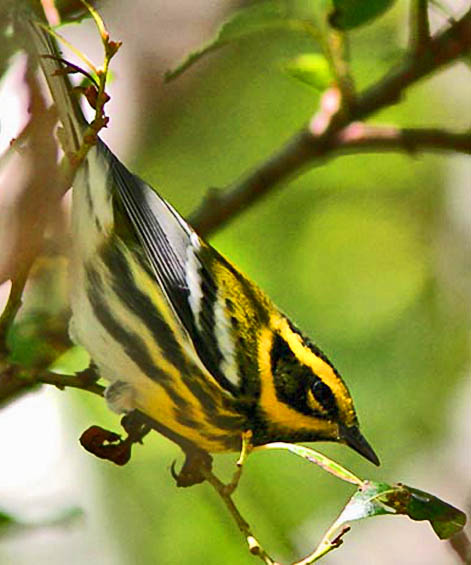 The New World Warblers, sometimes called "Wood Warblers" or "Parulids" is a large family of small, and often colorful, passerines that breed only in the New World. There are 50 species of wood warblers that regularly breeding in the continental United States and Canada, and all are migratory to some greater or lesser extent. A fair number of them migrate to the Neotropics for the winter. Few North American avian phenomena can compare to the return of these Neotropical migrants in the spring. The warbler migration spectacle is most impressive in the East, where places from Magee Marsh, Ohio, to Pt. Pelee, Ontario to Central Park, New York City, and from High Island, Texas to the Dry Tortugas, Florida, can come alive with hundreds of beautiful ornaments in the just-budding trees when conditions are right. Just one such ornament is Magnolia Warbler (above), a boreal forest breeder. The New World Warblers, sometimes called "Wood Warblers" or "Parulids" is a large family of small, and often colorful, passerines that breed only in the New World. There are 50 species of wood warblers that regularly breeding in the continental United States and Canada, and all are migratory to some greater or lesser extent. A fair number of them migrate to the Neotropics for the winter. Few North American avian phenomena can compare to the return of these Neotropical migrants in the spring. The warbler migration spectacle is most impressive in the East, where places from Magee Marsh, Ohio, to Pt. Pelee, Ontario to Central Park, New York City, and from High Island, Texas to the Dry Tortugas, Florida, can come alive with hundreds of beautiful ornaments in the just-budding trees when conditions are right. Just one such ornament is Magnolia Warbler (above), a boreal forest breeder.
Where I live — in California— huge fallouts are rare, but still the arrival of a wide variety of colorful warblers, such as Townsend's Warbler (left) always brighten any day. Here, in central California, Townsend's arrives as a fall migrant. I think fully black-throated males are about as pretty as any warbler, and I delight in having quite a few winter in the Monterey Pines around my house. In spring, before they depart, their very high-pitched up-spiraling songs are a great addition to the warming spring days.
In North America, I think of "eastern warblers" as divided between those breeding from the Canadian taiga to the northeastern woodlands — a suite of warblers that includes Magnolia — and those that breed in southeastern U.S. cypress swamps, gilded with Spanish moss. A male Prothonotary Warbler (below) simply glows among those dark hardwood bottomlands. |
|
The parulids are nine-primaried, primarily insectivorous songbirds that are closely related to the Emberizids and such groups as tanagers (Thraupidae) or icterids (Icteridae). Molecular evidence suggest they are a relatively recent radiation, and Sibley & Ahlquist (1990) lumped them all together in a single giant Emberizidae family, with the various groups assigned to subfamilies. In this century, the authorities have gone the opposite way. Following Barker et al. (2004, 2013), the major world checklists have followed the AOC Check-list and split the assemblage into over a dozen families, some of them as young as only 10 million years ago. The Parulidae is again a family, but it is now lacking oddities as the ground-creeping Wrenthrush Zeledonia coronata of Costa Rica and w. Panama (now in its own family); various Caribbean endemics now also assigned to separate families; various "chats," some of them now in the Cardinalidae, and Yellow-breasted Chat (now also in its own family).
What amazes me to this day is that while most of the North American parulids are limited in breeding range to the eastern United States and Canada, all of them are migrants that "spin off" vagrants to the west. For example, from Dec 2016 into Jan 2017, a Louisiana Waterthrush (above) attempted to winter along the Big Sur River among the towering redwoods at Pfeiffer-Big Sur State Park. To watch this southeastern swampland species pick its way through redwood and Fremont cottonwood leaves was truly remarkable. |
There are 49 New World warblers regularly breeding in the continental United States and Canada. All are migratory to some extent, which means than all are possible vagrants outside their normal migration routes. In California, the search for vagrant warblers in spring and fall migration is a major highlight of the birding year. While attending college in the San Francisco Bay area, I volunteered to help band birds on SE Farallon I., 27 miles west of San Francisco in the Pacific. In late May and June, and again in autumn, "wrong-way" migrants land on that rocky outcrop and are netted, banded, and released. The handful I'm holding (right) in June 1977 has a Northern Parula and a Chestnut-sided Warbler.
Now I live on the California coast in Monterey County. Not surprisingly, most of my recent photos of of New World Warblers were taken in Monterey County. This gorgeous male Black-throated Blue Warbler (right) was a fall migrant at the famed Moonglow Dairy, where it foraged among tall blue-gum eucalyptus native to Australia, and looking entirely out of place.
Adult Black-throated Blues do not molt into a winter plumage, but many migrant parulids change to less conspicuous plumages in winter, and all hatch-year migrants are in even less colorful plumages. The Peterson field guides called these "confusing fall warblers." In California, most vagrants warblers are first-year birds flying the "wrong-way" in fall (some on a "mirror-image" misorientation, similar in concept to dyslexia. Serious birders have become familiar with Blackpoll Warbler (below) in formative plumage. We see a few of them in Monterey County annually — spring adults occur very rarely. |
|
|
|
|
One the rarer, and quite lovely, species to reach California is Yellow-throated Warbler (above), shown here in a Pacific Grove tree festooned with lichens, recalling the Spanish moss of the southeastern U.S., where it breeds.
Forty-six of the 49 breeding North American species have reached California; all but Kirtland's Setophaga kirtlandii, (breeds c. Michigan, winters Bahamas), Colima Leiothlypis crissalis (a n. Mexico bird that breeds in Big Bend NP, Texas), and Swainson's Limnothlypis swainsonii (breeds se. U.S., winters mostly Greater Antilles). I have personally seen 45 of these 46 — all but Golden-cheeked Warbler Setophaga chrysoparia, which breeds only in central Texas. There is a single record from the Farallones in Sep 1971.
Perhaps even more remarkable to me is that 21 species have appeared in our small yard in the pine forest near Pt. Pinos on the tip of the Monterey Peninsula: 8 are migrant western warblers, more or less expected, but 12 have been "eastern" or "southwestern" rarities. The gallery of three warbler photos to the left are some of those "yard" birds:
- Hermit Warbler (left, upper) is a western migrant, but scarce here. Just one or two visit our bird-bath & fountain each spring or fall;
- Grace's Warbler (left, middle) is a major California rarity, with just 43 State records as of 2003 (CBRC 2007), and almost all in southern California. My bird on 6 Sep 2014 was just the second Monterey Co. record but, alas, was present just a brief time before it disappeared; and
- Blue-winged Warbler (left, lower) is also a California "mega" (just 35 CBRC endorsed as of 2003) but was the 6th for Monterey County, making brief appearances at the bird-bath 24 & 26 May 2017.
Ovenbird is also among the yard rarities, found by my wife Rita Carratello, but this particular Ovenbird (below) was walking in the undergrowth at a local cemetery just a few blocks from our house. Rita was also a finder of this unexpected vagrant. |
|
|
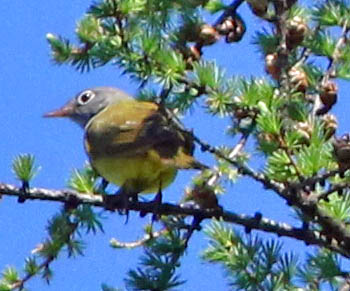 A fair number of New World Warblers are skulkers, hard to see at the best of times, and even more shy in migration. These include a group that used to be known as the "Oporornis" warblers — Mourning Warbler (female shown above), MacGillivray's Warbler O. tolmiei, Kentucky Warbler O. formosus, and Connecticut Warbler (left, a territorial male high in a spruce in northern Minnesota). After molecular analysis reshuffled the genera (e.g., Lovette et al. 2010), only Connecticut was left in genus Oporornis. The rest were moved to genus Geothlypis, which had been thought of as the "yellowthroat" genus. Highly sought be field observers, there are identification pitfalls to avoid; among the first papers to sort these out was Pyle & Henderson (1990). A fair number of New World Warblers are skulkers, hard to see at the best of times, and even more shy in migration. These include a group that used to be known as the "Oporornis" warblers — Mourning Warbler (female shown above), MacGillivray's Warbler O. tolmiei, Kentucky Warbler O. formosus, and Connecticut Warbler (left, a territorial male high in a spruce in northern Minnesota). After molecular analysis reshuffled the genera (e.g., Lovette et al. 2010), only Connecticut was left in genus Oporornis. The rest were moved to genus Geothlypis, which had been thought of as the "yellowthroat" genus. Highly sought be field observers, there are identification pitfalls to avoid; among the first papers to sort these out was Pyle & Henderson (1990).
All of these are Neotropical migrants, wintering primarily from Central America to northwestern South America, and on some Caribbean islands. The range of Connecticut appears to include the Amazon Basin. It is the ultimate in "difficult" American warblers, breeding in humid, mosquito-thick spruce bogs in summer, and then almost entirely overlooked in migration due to its retiring ground-walking behaviors. In California, the majority of records were netted on SE Farallon I., a barren rock with but two tiny planted trees. Incidentally, "Connecticut Warbler" is one of the worst English names given to any species. Alexander Wilson first described this species in 1812 and named it after the state of Connecticut, where he collected the first specimen, a fall migrant. However, the species does not breed in Connecticut, nor is it a common migrant there.
North America has two seriously endangered species [Golden-cheeked Warbler Setophaga chrysoparia, breeding in central Texas, and Kirtland's Warbler, breeding in jack-pine woods in central Michigan and wintering in the Bahamas). There used to be one more — Bachman's Warbler Vermivora bachmanni — but it went extinct the late 20th century with the loss of its cane filled swampy bottomlands in the southeastern United States. |
The genus Geothlypis used to be composed only of nine species of "yellowthroat," but as not just above, it now includes some of the former "Oporornis" warblers. Most yellowthroats are local residents of isolated or island marshes, but Common Yellowthroat is a widespread breeder, migrant, and wintering species throughout much of North America. This Common Yellowthroat (right) is a male of the subspecies arizela, one of up to 15 races.
As there are about 50 parulids in North America, there are many interesting topics among them. Migration and vagrancy interest many birders, but the complex pattern. I enjoy seeing the range of plumage variation in warbler of differing ages and sexes. Contrast this first-summer American Redstart (just below) with a vigorous singing adult male American Redstart on spring migration in Ohio (below right). The first-summer male was found in July by my wife Rita Carratello, here locally near Carmel, when it still had a tail feather, but was tail-less by the time of my photo. It remained a month and replaced its tail before departing in August. |
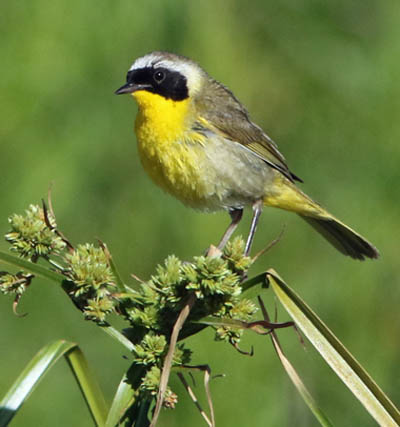 |
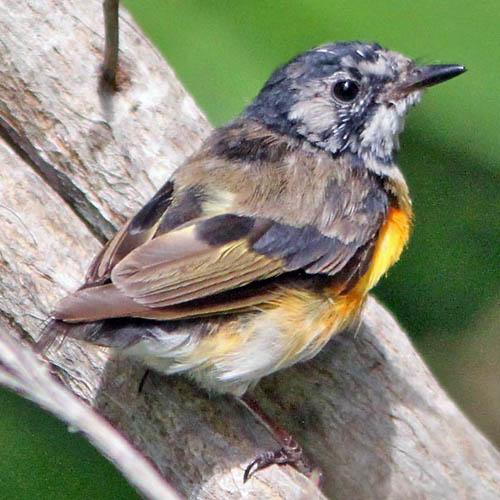 |
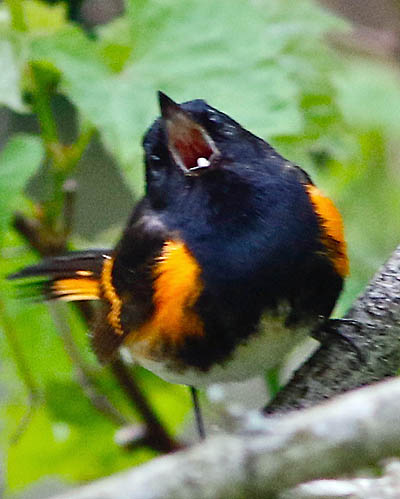 |
|
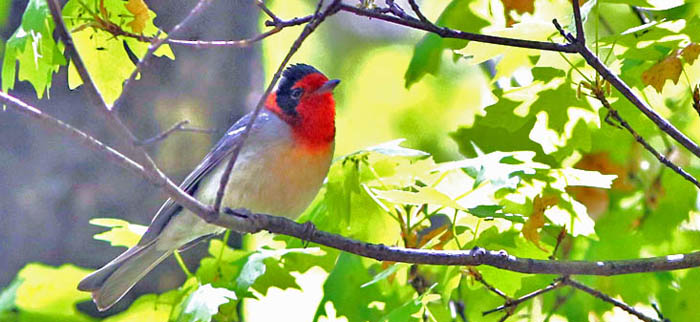 Another highly sought-after set of North America parulids breed in the mountains of southeastern Arizona and down into Mexico. One of those is the pine-loving Grace's Warbler, already mentioned above as one once appeared briefly in my backyard. The loveliest of them to my eye is Red-faced Warbler, of montane sycamore and oak habitats (right). Another highly sought-after set of North America parulids breed in the mountains of southeastern Arizona and down into Mexico. One of those is the pine-loving Grace's Warbler, already mentioned above as one once appeared briefly in my backyard. The loveliest of them to my eye is Red-faced Warbler, of montane sycamore and oak habitats (right).
Also in the southwest are Virginia's Warbler Leiothlypis virginiae, breeding in brushy foothills; Lucy's Warbler L. luciae in the mesquite deserts; Grace's Warbler S. graciae of pine forests in the mountains; and Colima Warbler L. crissalis, a Mexican species that nests in the U.S. only in Big Bend NP in west Texas.
The U.S. states that border Mexico — especially southern Arizona to southern Texas — are known among American birders for the one or two Mexican vagrant warblers that can appear at any date. Those that reach the mountains of southeastern Arizona in spring sometimes even find a mate and attempt to nest in the United States. Rufous-capped Warbler (just below, left) is among those rarities north of the border — an active, long-tailed warbler widespread in foothills and highlands of Mexico and Central America. Populations in north Mexico, like this individual, are gray-bellied, while those in southeast Mexico and Belize are extensively yellow below. Tropical Parula (just below, right) is widespread from Mexico to Argentina, but a few reach southern Texas (and have bred). This photo is of the only one to reach California, where it wintered in the backyard of a condominium project in an urban area of Orange County, southern California. |
|
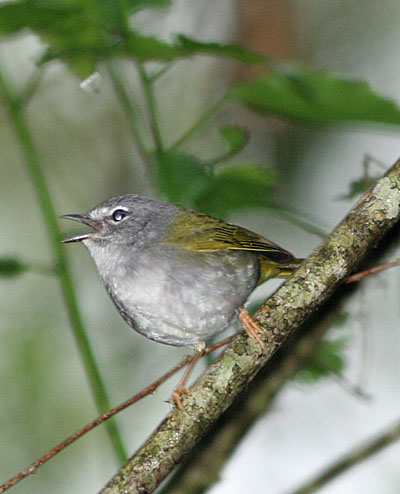 So far this page on family Parulidae has focused almost exclusively on North American migrants. Nearly all of these spend the winter in the Neotropics or on Caribbean islands, so they are, actually, part of the Neotropical avifauna for half-a-year. There are 11 endemic residents on Caribbean islands. What used to be Adelaide's Warbler Setophaga adelaidae, with populations on Puerto Rico, Bubuda, and St. Lucia, has been split into 3 species. My photo (just above, left) is of St. Lucia Warbler, endemic to that single island. Most of these endemics are assigned to the enlarged genera Setophaga (the old "Dendroica" warbler are embedded in that genus. The other St. Lucia endemic was Semper's Warbler Leucopeza semperi, but it is now appears to be extinct. Whistling Warbler Catharopeza bishopi of St. Vincent still exists as a skulker in montane undergrowth. So far this page on family Parulidae has focused almost exclusively on North American migrants. Nearly all of these spend the winter in the Neotropics or on Caribbean islands, so they are, actually, part of the Neotropical avifauna for half-a-year. There are 11 endemic residents on Caribbean islands. What used to be Adelaide's Warbler Setophaga adelaidae, with populations on Puerto Rico, Bubuda, and St. Lucia, has been split into 3 species. My photo (just above, left) is of St. Lucia Warbler, endemic to that single island. Most of these endemics are assigned to the enlarged genera Setophaga (the old "Dendroica" warbler are embedded in that genus. The other St. Lucia endemic was Semper's Warbler Leucopeza semperi, but it is now appears to be extinct. Whistling Warbler Catharopeza bishopi of St. Vincent still exists as a skulker in montane undergrowth.
After the most recent taxonomic revisions (e.g., Lovette et al. 2010), parulids were assigned to 18 genera (but as just noted, the lone Leuocpeza is extinct). Most of the 38 species of Central and South America resident warblers are assigned to just 3 genera: Basileuterus (which includes Rufous-capped, shown just above as a vagrant to Arizona, Myiothlypis, and Myioborus. The latter genus holds the "redstarts" (except American Redstart), sometimes called "whitestarts," that generally prefer montane forests and which flick or fan their tails white foraging in the canopy. This colorful tropical warbler (just above, right) in Collared Redstart of Costa Rica and western Panama.
Genus Myiothlypis is comprised of 15 species of (mostly) South American warblers that range from lowlands to highlands across the continent. This Myiothlypis (right) is White-lored Warbler, range restricted to southeastern Brazil and adjacent countries. It is vigorously singing in this shot — a melodious series of descending notes. |
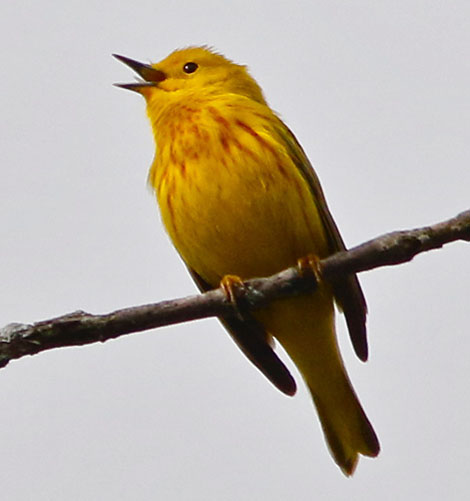 |
Yellow Warbler has a variety of populations: a migratory population of North American breeders that winter farther south, and then coastal and/or island populations in the tropics or Caribbean that are resident. Compare our North American singing male Yellow Warbler (upper left) with a resident "golden" male in Cuba (lower left), sometimes called "Mangrove Warbler" or "Golden Warbler."
Some recent authors suspect that the breeding populations in South America and the Caribbean represent one or more separate species from North American wintering populations there. Ridgely & Greenfield (2001) used a two-species classification, with North American populations as one species, S. aestiva ("Yellow Warbler") and tropical populations as another, S. petechia ("Mangrove Warbler"). A three-species split was used by Hilty (2003), who separated tropical populations: Pacific coastal populations S. erithachorides ("Mangrove Warbler"), and Caribbean S. petechia ("Golden Warbler"). A SACC proposal to split Yellow Warbler into two or more species did not pass due to insufficient published data. We might anticipate a split in the future.
Even if our North American population were split as "the" Yellow Warbler, there is substantial variations in plumages of younger birds. Note just how gray and dull with (presumably) hatch-year Yellow Warbler can be (below). |
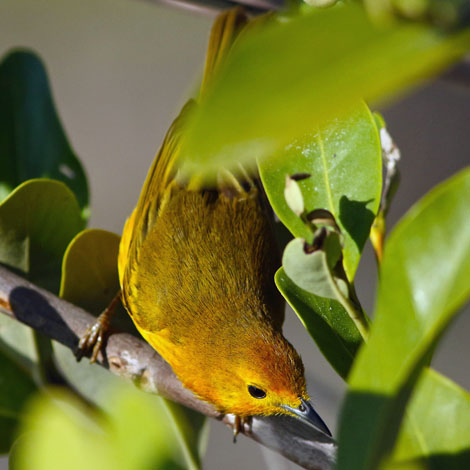 |
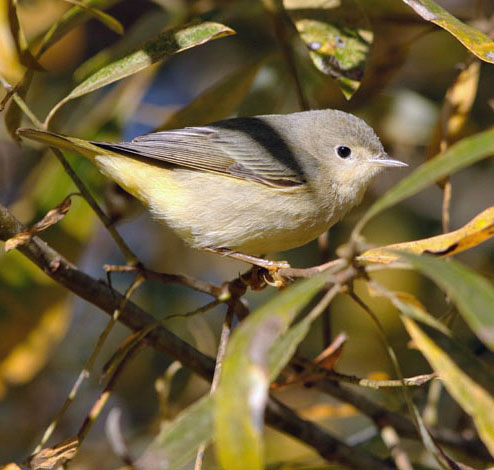 |
|
|
Another taxonomic issue involves the current Yellow-rumped Warbler. For over 100 years the population in the west was known as "Audubon's Warbler" (above left) and those in the east were called "Myrtle Warbler" (above right). In 1973, AOU ornithologists lumped them based on evidence that the two taxa hybridized in a narrow zone in western Canada. With the merger, the species was renamed Yellow-rumped Warbler (the yellow rump shows nicely on the Myrtle photo). Locally, the colloquialism became "butter-butt," and that is how they are often used in the field: "there's a butter-butt over there." Audubon's has a yellow throat. Myrtle has a white throat. That is most impressive impressive when, with their spring body molt, they acquire breeding plumage. Both species show conspicuous white tail spots in flight. Both types are regular in winter in coastal California, with Audubon's very common among a variety of habitats, while Myrtle's is restricted to willow thickets and cottonwoods groves. I suspect they will be split again someday in the future.
Things do change over time. At one time there were three species of Wilsonia warblers: Wilson's Warbler, Canada Warbler (below left, in the northeast), and Hooded Warbler (below right, in the southeast). Wilson's Warbler W. pusilla itself had been originally described by Alexander Wilson, one of the first American ornithologists. It was DNA evidence, provided by Lovette et al. (2010), that changed long-established scientific names. The evidence suggested that Hooded Warbler was most closely related to American Redstart, and was moved to genus Setophaga. Wilson's and Canada were genetically nearer to Red-faced Warbler, in genus Cardellina. As a result, the genus Wilsonia disappeared as the two species were merged into Cardellina, as well as two Middle American species formerly placed in the genus Ergaticus: Red Warbler C. ruber of central Mexico, and Pink-headed Warbler C. versicolor of Chiapas and Guatemala. All of the former Wilsonia warblers are migratory. Wilson's is a common breeder here in Monterey County, but Canada and Hooded remain rare vagrants — each of these below were photographed in Monterey County: a fall-migrant young Canada Warbler (just below, left) and a spring male adult Hooded Warbler (just below, right). Finally, the last photo (second row below) is a Northern Parula — for whom the family name Parulidae originated — feasting on an outbreak of lerps on eucalyptus on the last day of December 2017. What a colorful photo that makes! |
|
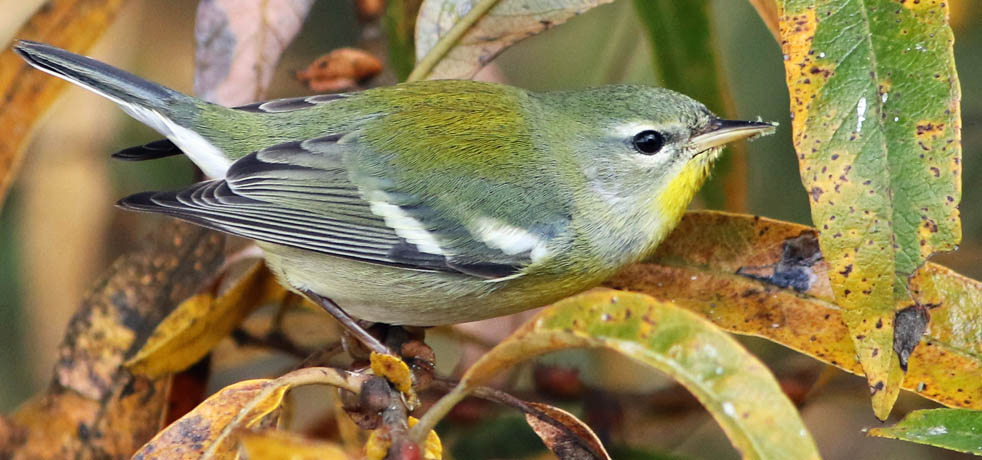 |
| |
Photos: The male Magnolia Warbler Setophaga magnolia was at Magee Marsh, Ohio, USA, on 21 May 2019. The male Townsend's Warbler S. townsendi was at along the Carmel River, Monterey County, California, on 24 Sep 2005. The male Prothonotary Warbler Protonotaria citrea was at Magee Marsh, Ohio, USA, on 21 May 2019. The winter Louisiana Waterthrush S. townsendi was along the Big River in Pfeiffer-Big Sur SP, California, on 24 Dec 2017. The handheld Northern Parula Setophaga americana and Chestnut-sided Chestnut-sided Warbler S. pensylvanica was on S.E. Farallon I. on 20 June 1977 (Ron LeValley snapped this shot of me holding the birds with my camera). The male Black-throated Blue Warbler S. caerulescens was at Moonglow Dairy, Monterey Co., CA, on 13 Oct 2016. The fall Blackpoll Warbler S. striata was at Laguna Grande Park, Monterey County, CA, on 13 Oct 2014. The Yellow-throated Warbler S. dominica was in Pacific Grove, Monterey Co., CA, on 3 Oct 2019. The gallery of birds in my backyard in Pacific Grove, Monterey Co., CA, are: female Hermit Warbler S. occidentalis on 26 Apr 2005; a Grace's Warbler Setophaga graciae on 6 Sep 2014; and a Blue-winged Warbler Vermivera cyanoptera on 26 May 2017. The Ovenbird Seiurus aurocapilla was walking in the Pacific Grove, CA, cemetery on 28 Sep 2014. The female Mourning Warbler Geothlypis philadelphia was shot from a photo-blind at High Island, Texas, on 28 Apr 2014. The male Connecticut Warbler Oporornis agilis was in the Sax Zim Bog, Minnesota, on 5 June 2017. The male Common Yellowthroat Geothlypis trichas arizela was at Zmudowski SB, Monterey Co., CA, on 20 June 2016. The male Townsend's Warbler S. townsendi was at was at the Carmel River mouth, Monterey County, California, on 24 Sep 2005. The tail-less American Redstart Setophaga ruticilla was at Hatton Canyon, Monterey Co., CA, on19 July 2014, and the singing male American Redstart at Magee Marsh, Ohio, on 21 May 2019. The male Red-faced Warbler Cardellina rubrifrons was in Ramsay Canyon, southeastern Arizona, on 30 Apr 2018. The Rufous-capped Warbler Basileuterus rufifrons was in Hunters Canyon, southeastern Arizona, on 29 Apr 2018. The male Tropical Parula Setophaga pitiayumi was wintering in Orange County, CA, on 7 Jan 2018. The endemic St. Lucia Warbler Setophaga delicata was on St. Lucia in March 2000. The Collared Redstart Myioborus torquatus was at Savegre, Costa Rica, on 24 Dec 2007. The singing White-lored Warbler Myiothlypis conspicillata was at Intervales NP, Brazil, on 2 Aug 2010. The singing male Yellow Warbler S. petechia was at at Magee Marsh, Ohio, USA, on 21 May 2019; the male "Golden" Yellow Warbler was in Zapata Swamp, Cuba, on 8 Feb 2017, and the very dull hatch-year migrant Yellow Warbler was at Laguna Grande Park, Monterey County, California, on 27 Dec 2018. The Yellow-rumped (Audubon's) Warbler Setophaga coronata auduboni was at San Lorenzo Park, King City, Monterey Co., CA, on 12 Oct 2018, and the Yellow-rumped (Myrtle) Warbler Setophaga coronata coronata was digi-scoped at Monterey, CA, on 29 Jan 2005. The imm female Canada Warbler Cardellina canadensis was at the Frog Pond Preserve, Monterey County, California, on 11 Sep 2018. The male Hooded Warbler Setophaga citrina was at Don Davee Park, Monterey, CA, on 9 July 2016. The lerp-eating Northern Parula Setophaga americana and at the Laguna Grande Park, Monterey County, California, on 31 Dec 2017.
All photos © Don Roberson; all rights reserved.
Bibliographic note: There are quite a few books that cover some of the New World warblers. Most of these do not include the entire family — with its Neotropical and/or Caribbean representatives — and therefore there are few actual "family books" per se. Those listed below, some of them now quite old, cover all the basic North American breeding species and attempt, in general, to provide a family portrait. These reviews were written more than 10 years ago for an earlier version of this Parulidae page. A good introduction now is Curson (2010) in the Handbook of the Birds of the World series.
Family Books: 
Curson, Jon. 1994. Warblers of the Americas: an Identification Guide. Houghton Mifflin, Boston.
This is only true "family book" in that it covers the 116 species of Parulidae then-recognized by the author (including a couple recently extinct ones, and some now assigned to other families). It includes color plates (by David Quinn and David Beadle) of all the species. This effort strongly resembles a Pica Press family book with plates in one location with facing text, and the main text elsewhere. Like all these generic family books, it bogs down in detailed plumage descriptions which fail to answer the 'big picture' of how to separate the difficult ones. I owned this book for several years but became disillusioned with it, since it rarely had the answers to 'state-of-the-art' questions. The author was up on much of the literature, and did (for example), cite Pyle & Henderson's (1990) paper on identification of Oporornis, but — inevitably — it had to summarize those topics, and thus lost the fine details actually needed. In almost all situations, I found it necessary to go to the primary papers. On a more general level, the overview of the family was okay, and the plates adequate (but not enticing), and I eventually sold the book. The value of this book decreased significantly with the publication of Dunn & Garrett (1997), acknowledged experts on North American species. It didn't help that Warblers of the Americas was written and illustrated by British collaborators. No doubt they did a lot of research, but I never felt they really "knew" these American birds.
Family book: 
Dunn, Jon, and Kimball Garrett. 1997. A Field Guide to the Warblers of North America. Houghton Mifflin, Boston.
This field-guide-sized book covers only North American warblers (but includes Baja California and Mexican vagrants that have crossed the U.S. border); it is thus not meant to be a true "family" book. At 60 species is has a bit over half of the family. Yet that half is covered exceptionally well from the perspective of identification, distribution, sub-specific variation, and migration. The authors, renowned experts in field identification, discuss the range of variation in each species, and identify the obvious — and not so obvious — pitfalls. At the moment, this book is definitive on most major i.d. topics, including a full discussion of voice. The authors give special attention to detailed information on ageing and sexing each warbler. I give it high marks in these areas. That having been said, the sections of behavior and habitat and other biological topics are short, and the main text suffers from a lack of citations. This is an identification and distribution guide, not a more generalized survey of all that is known about warblers. It is also an odd size for a family book, having field guide dimensions (rendering all the paintings and photos quite small) but being very thick. Surely no one will carry it in the field; it is presumably meant for the car. But I prefer my family books on shelves at home, and this odd small-and-thick shape is not conducive to easy use. The paintings (by Thomas Schultz and Cindy House) range from excellent to okay, and I appreciated the scattering of color photos throughout. Yet in many cases I still wanted better illustrations of particularly difficult points. The detailed range maps for the U.S. and Canada, though, are excellent.
Family book: 
Harrison, Hal H. 1984. Wood Warblers' World. Simon & Schuster, New York.
In many respects, this is the opposite approach to presenting North American warblers (53 species here) from Dunn & Garrett (1997). This book's emphasis is on breeding biology, habitat, life history, and such matters, with only the briefest of remarks on identification, sub-specific variation, or detailed distributional information. At the level of biology, the text is all-too-brief and the bibliography rather short, but it is entertainingly written. The style is anecdotal — even when citing serious studies — and we get the feeling that the author really enjoys warblers. He is inclined to opine on most anything, from why the name "Worm-eating Warbler" is a poor one to why campground locations in Perdenales State Park, Texas, are poor. But the book is packed with a lot of the author's photos — mostly of warblers on the nest — plus a variety of black-and-white habitat shots. These are evocative and in some cases quite wonderfully, recalling the fabulous series of wood-warbler nesting photos published by Eliot Porter.
Family book: 
Griscom, L., and A. Sprunt, Jr., eds. 1957; rev ed. 1979. The Warblers of North America. Devin-Adair Co., New York.
This was the first major review of North American warblers. Now quite dated, it provided a mid-20th-century overview of distribution, migration, and life history, accompanied by paintings of John H. Dick and others. Some of the paintings were nice, and again some anecdotes remain poignant, but time has passed this one by.
There is yet another book, Douglas Morse's (1989) The American Warblers, that I have not seen. It has a comprehensive review of the behavior and ecology of wood-warblers, and comes highly recommended by Dunn & Garrett (1997). Although it apparently does not deal with identification, distribution, or vagrancy, it may have a good information on other topics.
Literature cited:
Barker, F.K., A. Cibois, P. Schikler, J. Feinstein, and J. Cracraft. 2004. Phylogeny and diversification of the largest avian radiation. Proc. Natl. Acad. Sci. 101: 11040–11045.
Barker, F.K., K.J. Burns, J. Klicka, S.M. Lanyon, and I.J. Lovette. 2013. Going to extremes: contrasting rates of diversification in a recent radiation of New World passerine birds. Syst. Biol. 62: 298–320.
California Bird Recorder Committee (CBRC; R.A. Hamilton, M.A. Patten, and R.A. Erickson, eds.). 2007. Rare Birds of California. West. Field Ornith., Camarillo, CA.
Curson, J.M. 2010. Family Parulidae (New World Warblers), pp. 666–800 in Handbook of the Birds of the World (del Hoyo, J., A. Elliott & D.A. Christie, eds). Vol. 15. Lynx Edicions, Barcelona, Spain.
Curson, J.M., D. Quinn, and D. Beadle. 1994. New World Warblers. Christopher Helm, London [published in U.S. as Warblers of the Americas: an identification guide. Houghton Mifflin, New York].
Dunn, J., and K. Garrett. 1997. A Field Guide to the Warblers of North America. Houghton Mifflin, Boston.
Lovette, I.J., J.L. Pérez-Emán, J.P. Sullivan, R.C. Banks, I. Fiorentino, S. Córdoba-Córdoba, M. Echeverry-Galvis, F.K. Barker, K.J. Burns, J. Klicka, S.M. Lanyon, and E. Bermingham. 2010. A comprehensive multilocus phylogeny for the wood-warblers and a revised classification of the Parulidae (Aves). Molec. Phylog. Evol. 57: 753–770.
Pyle, P., and P. Henderson. 1990. On separating female and immature Oporornis in fall. Birding 22: 222–229.
Roberson, D. 2002. Monterey Birds, 2d ed. Monterey Pen. Audubon Soc., Carmel, CA. .
Sibley, C.G., and J.E. Ahlquist. 1990. Phylogeny and Classification of Birds: a Study of Molecular Evolution. Yale Univ. Press, New Haven, CT.
|
|
|



 The New World Warblers, sometimes called "Wood Warblers" or "Parulids" is a large family of small, and often colorful, passerines that breed only in the New World. There are 50 species of wood warblers that regularly breeding in the continental United States and Canada, and all are migratory to some greater or lesser extent. A fair number of them migrate to the Neotropics for the winter. Few North American avian phenomena can compare to the return of these Neotropical migrants in the spring. The warbler migration spectacle is most impressive in the East, where places from Magee Marsh, Ohio, to Pt. Pelee, Ontario to Central Park, New York City, and from High Island, Texas to the Dry Tortugas, Florida, can come alive with hundreds of beautiful ornaments in the just-budding trees when conditions are right. Just one such ornament is Magnolia Warbler (above), a boreal forest breeder.
The New World Warblers, sometimes called "Wood Warblers" or "Parulids" is a large family of small, and often colorful, passerines that breed only in the New World. There are 50 species of wood warblers that regularly breeding in the continental United States and Canada, and all are migratory to some greater or lesser extent. A fair number of them migrate to the Neotropics for the winter. Few North American avian phenomena can compare to the return of these Neotropical migrants in the spring. The warbler migration spectacle is most impressive in the East, where places from Magee Marsh, Ohio, to Pt. Pelee, Ontario to Central Park, New York City, and from High Island, Texas to the Dry Tortugas, Florida, can come alive with hundreds of beautiful ornaments in the just-budding trees when conditions are right. Just one such ornament is Magnolia Warbler (above), a boreal forest breeder.
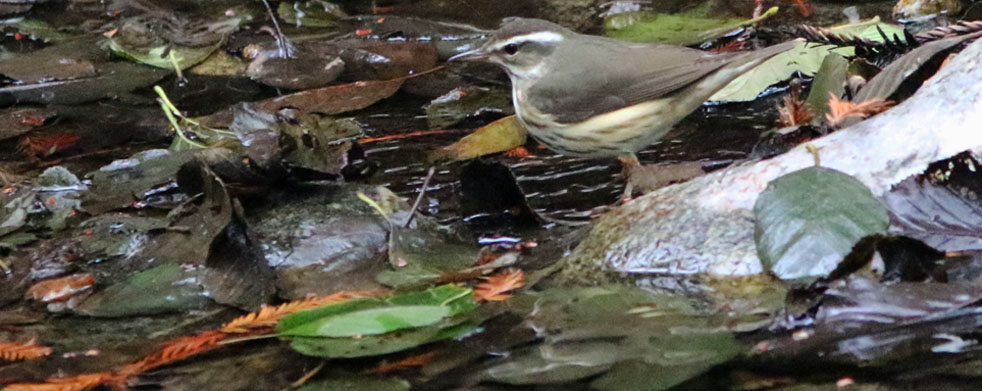
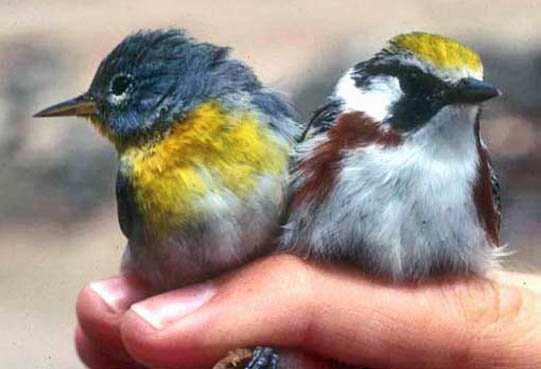
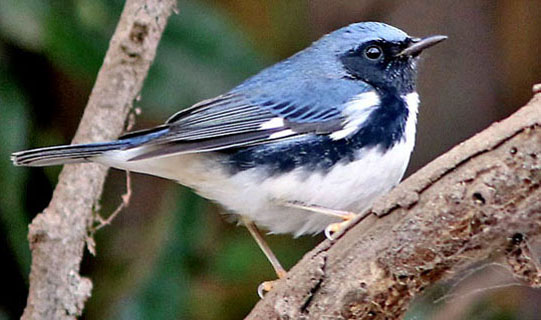
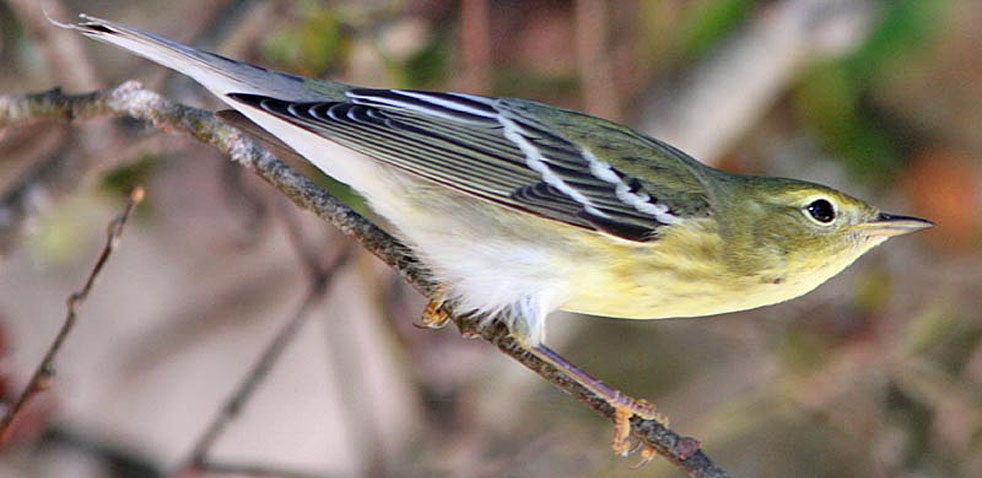
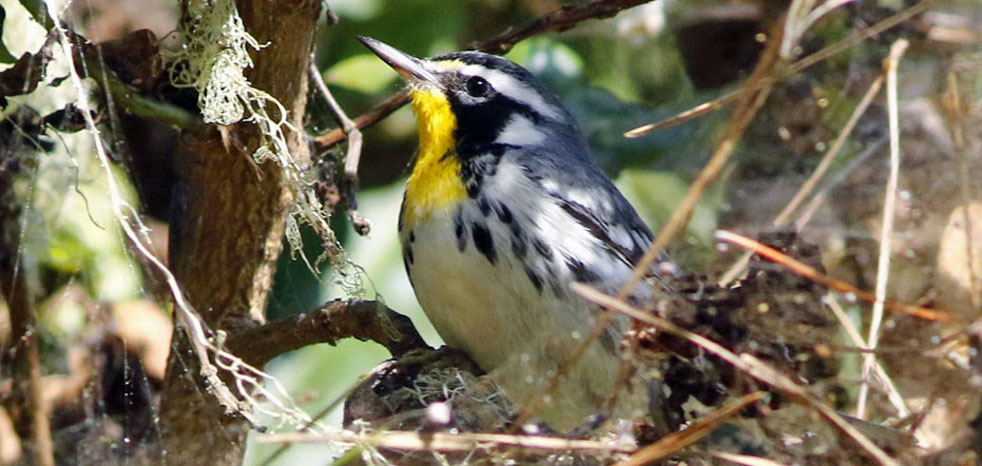
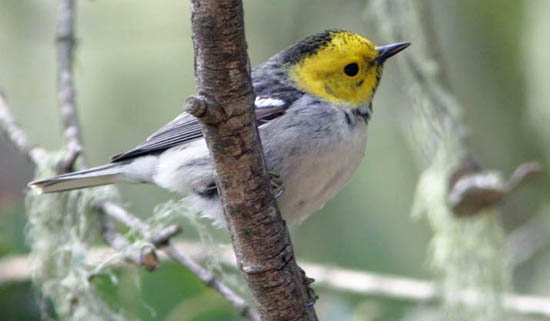
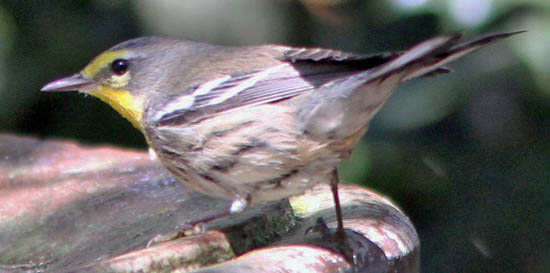
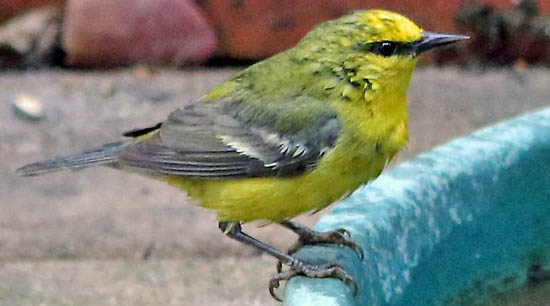
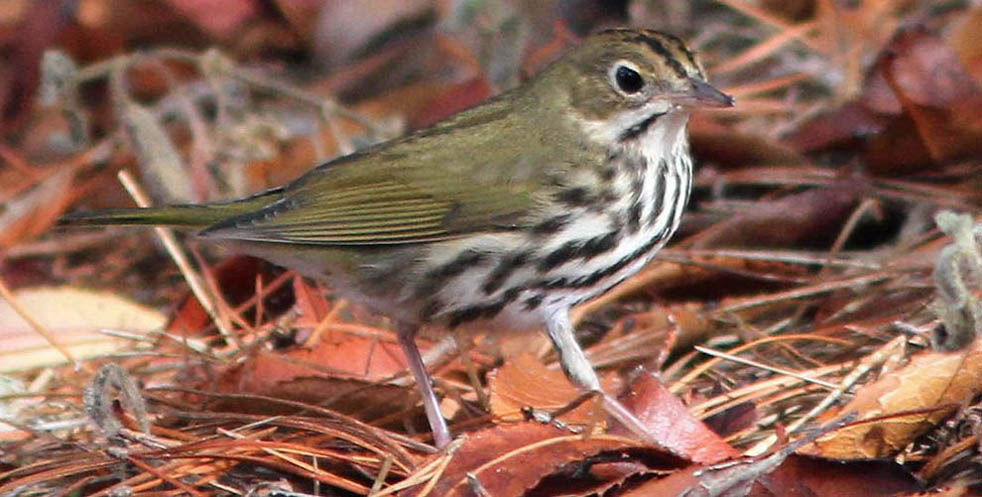
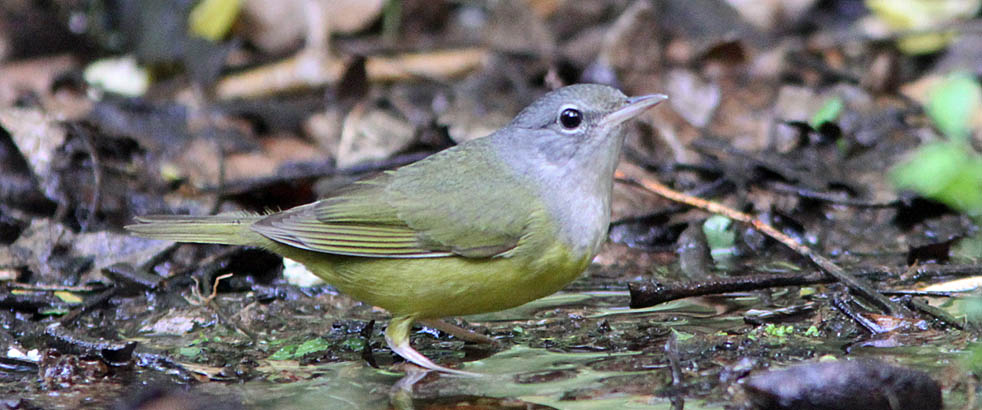
 A fair number of New World Warblers are skulkers, hard to see at the best of times, and even more shy in migration. These include a group that used to be known as the "Oporornis" warblers — Mourning Warbler (female shown above), MacGillivray's Warbler O. tolmiei, Kentucky Warbler O. formosus, and Connecticut Warbler (left, a territorial male high in a spruce in northern Minnesota). After molecular analysis reshuffled the genera (e.g., Lovette et al. 2010), only Connecticut was left in genus Oporornis. The rest were moved to genus Geothlypis, which had been thought of as the "yellowthroat" genus. Highly sought be field observers, there are identification pitfalls to avoid; among the first papers to sort these out was Pyle & Henderson (1990).
A fair number of New World Warblers are skulkers, hard to see at the best of times, and even more shy in migration. These include a group that used to be known as the "Oporornis" warblers — Mourning Warbler (female shown above), MacGillivray's Warbler O. tolmiei, Kentucky Warbler O. formosus, and Connecticut Warbler (left, a territorial male high in a spruce in northern Minnesota). After molecular analysis reshuffled the genera (e.g., Lovette et al. 2010), only Connecticut was left in genus Oporornis. The rest were moved to genus Geothlypis, which had been thought of as the "yellowthroat" genus. Highly sought be field observers, there are identification pitfalls to avoid; among the first papers to sort these out was Pyle & Henderson (1990).


 Another highly sought-after set of North America parulids breed in the mountains of southeastern Arizona and down into Mexico. One of those is the pine-loving Grace's Warbler, already mentioned above as one once appeared briefly in my backyard. The loveliest of them to my eye is Red-faced Warbler, of montane sycamore and oak habitats (right).
Another highly sought-after set of North America parulids breed in the mountains of southeastern Arizona and down into Mexico. One of those is the pine-loving Grace's Warbler, already mentioned above as one once appeared briefly in my backyard. The loveliest of them to my eye is Red-faced Warbler, of montane sycamore and oak habitats (right).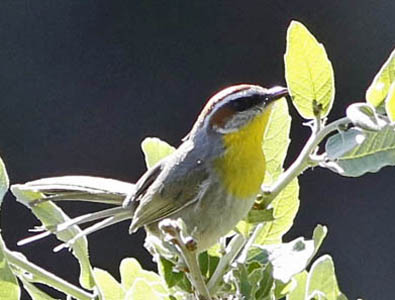
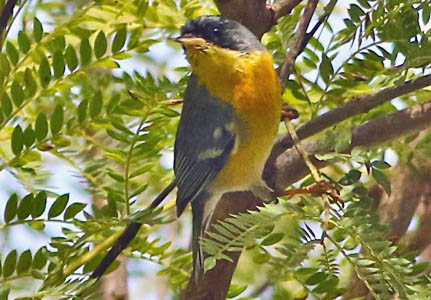
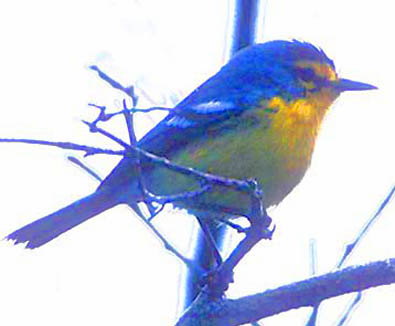
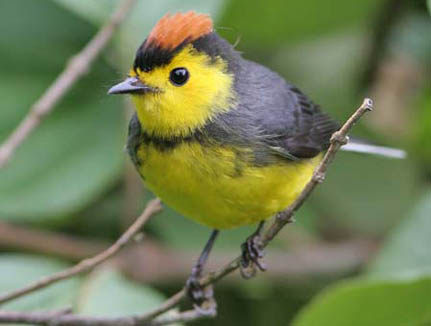
 So far this page on family Parulidae has focused almost exclusively on North American migrants. Nearly all of these spend the winter in the Neotropics or on Caribbean islands, so they are, actually, part of the Neotropical avifauna for half-a-year. There are 11 endemic residents on Caribbean islands. What used to be Adelaide's Warbler Setophaga adelaidae, with populations on Puerto Rico, Bubuda, and St. Lucia, has been split into 3 species. My photo (just above, left) is of St. Lucia Warbler, endemic to that single island. Most of these endemics are assigned to the enlarged genera Setophaga (the old "Dendroica" warbler are embedded in that genus. The other St. Lucia endemic was Semper's Warbler Leucopeza semperi, but it is now appears to be extinct. Whistling Warbler Catharopeza bishopi of St. Vincent still exists as a skulker in montane undergrowth.
So far this page on family Parulidae has focused almost exclusively on North American migrants. Nearly all of these spend the winter in the Neotropics or on Caribbean islands, so they are, actually, part of the Neotropical avifauna for half-a-year. There are 11 endemic residents on Caribbean islands. What used to be Adelaide's Warbler Setophaga adelaidae, with populations on Puerto Rico, Bubuda, and St. Lucia, has been split into 3 species. My photo (just above, left) is of St. Lucia Warbler, endemic to that single island. Most of these endemics are assigned to the enlarged genera Setophaga (the old "Dendroica" warbler are embedded in that genus. The other St. Lucia endemic was Semper's Warbler Leucopeza semperi, but it is now appears to be extinct. Whistling Warbler Catharopeza bishopi of St. Vincent still exists as a skulker in montane undergrowth.


